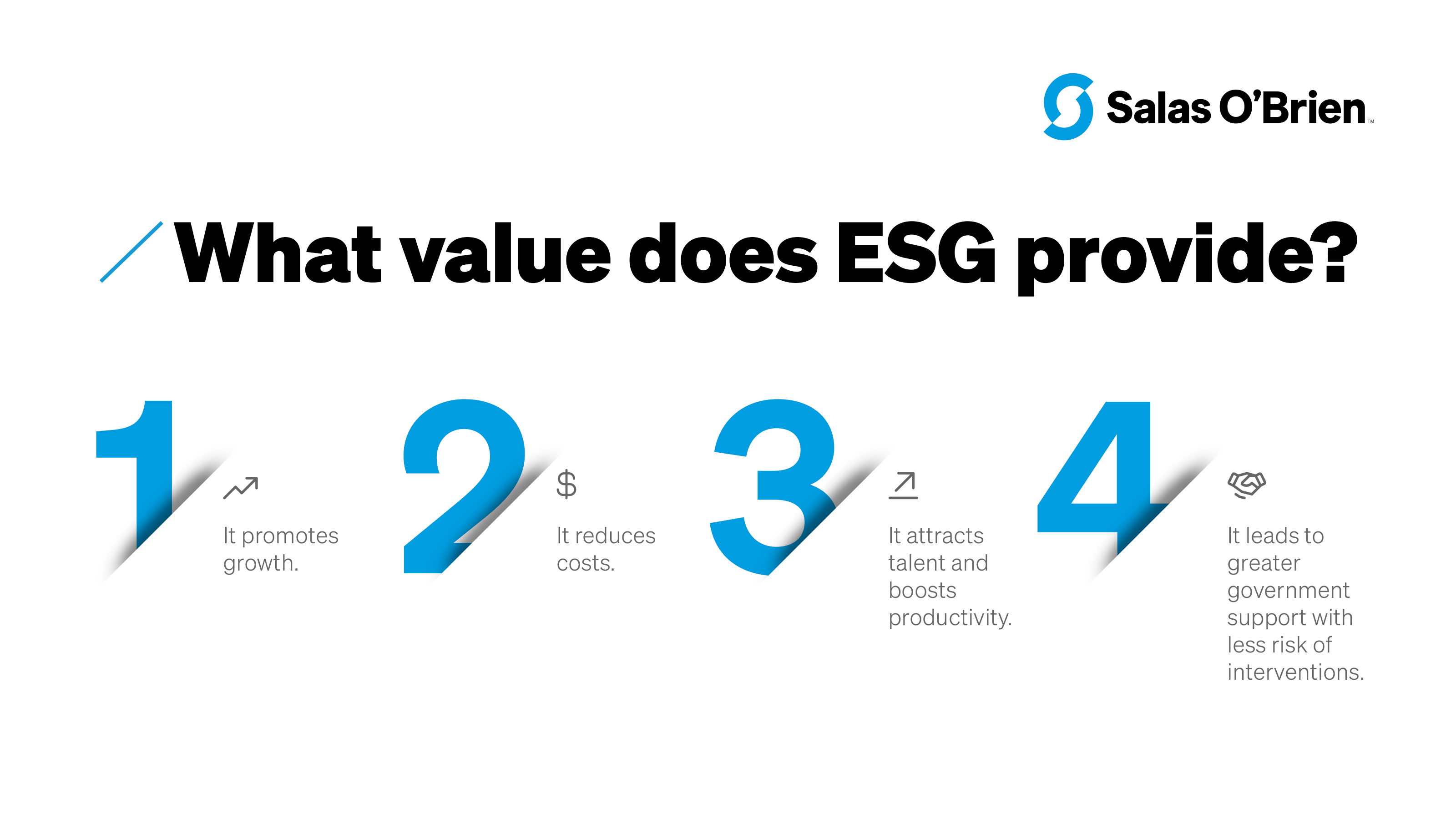News & Insights
Adopting ESG: what it is, its drivers, and how to take action
ESG, short for Environmental, Social, and Governance, has become a buzzword in the business world. However, for many companies, adopting ESG is an emerging conversation. This article aims to provide clarity by providing an overview of the key components of ESG and offering practical guidance on implementation.

What is ESG?
ESG is an umbrella term that encompasses a broad set of issues: sustainability, environmental impacts, social responsibility, labor practices, stakeholder management, community involvement, transparency, and corporate ethics, to name a few.
In practice, an effective ESG initiative examines a company’s environmental, social, and governance practices and then looks at their corresponding impacts. Each business has different goals, drivers, and regulations, thus requiring a customized approach to ESG. There are many different ESG reporting frameworks (such as GRI, SASB, GRESB, and ISSB), but the essential elements are benchmarking, measuring progress, and reporting on ESG factors; all while developing a plan to take action to improve them.
Broadly speaking, ESG can be viewed as a shift in the way we think about doing business today. The purpose of which is to make sure organizations account not only for their profit margins, but also the impacts they have on the environment and on society.
When considering ESG, businesses explore questions such as:
- To what degree are we managing our carbon footprint?
- What are we doing to enhance diversity and inclusion in our labor practices?
- How are we supporting the community in which we do business?
- To what degree are we transparent in our business operations and reporting?
- What are we doing to plan for the future to minimize risk and support our long-term viability?
- What are we doing to retain our stakeholders and acquire new investors?
The three pillars of ESG
Environmental. The E in ESG considers all of the environment-impacting activities of your business and how it manages environmental risks. It looks at resource consumption, waste discharge, and environmental effects. It includes considerations such as carbon footprint, wastewater discharge, resource scarcity management, animal treatment, climate risks, and potential extreme weather events.
Social. The S in ESG considers social criteria and examines the impact your business has on people and the broader community. This includes your relationships with employees, suppliers, and customers, and your reputation within the community. It looks at working conditions and examines internal policies related to labor, health, safety, inclusion, and diversity.
Governance. The G in ESG explores how your company shows compliance and transparency in your corporate operations. It examines the practices, policies, and procedures your company assumes to meet the needs of stakeholders and comply with government regulations.
The drivers behind ESG adoption
Demand for greater transparency on sustainable and socially responsible practices is on the rise. According to McKinsey research, more than 90% of S&P 500 companies now publish ESG reports in some form. In addition, regulatory disclosure adoption is on the rise across the globe, and the SEC is currently considering new rules that would require companies to disclose more details about climate-related risks and greenhouse-gas emissions.
So, what are the main drivers behind the ESG movement?
While some companies are doing it to support their own sustainability goals, derive reputational benefits, or comply with regulations, the majority are being driven to do it by stakeholders as a form of risk management.
Why are stakeholders—investors, lenders, government agencies, consumers, clients, and others—looking at ESG performance?
The answer is simple: ESG provides stakeholders with a way to measure a firm’s long-term viability by more than profits alone. It helps them assess a company’s risk exposure as well as its potential future financial performance.
Armed with an ESG report, stakeholders can now evaluate the quality of an organization’s business practices and corporate responsibility in a way that used to be reserved exclusively for internal management. In turn, stakeholders are using ESG performance when making investment decisions. For example, discounts may be applied when certain ESG focused lending criteria are met.
In terms of risk management, ESG provides protection, particularly during economic downturns. It looks at how a company’s financial position may be impacted by issues such as climate change, fair labor standards, corporate practices, and business ethics. In a post-pandemic world, it can help us learn to persevere through new kinds of market dynamics.
What value does ESG provide?
ESG’s value proposition is incredibly high. ESG practices benefit your business in numerous ways, driving value through both increased revenue and cost savings.
It has been demonstrated that ESG practices promote financial growth, reduce operating costs, fuel optimism, lessen volitivity, boost resiliency, reduce regulatory interventions, improve employee retention and productivity, attract new talent, promote top-line growth, target future consumers, facilitate brand enhancement, and encourage innovation.
Let’s take a look at 4 ways ESG drives value:
- It promotes growth. A smart ESG approach makes it easier for businesses to expand and attract new customers. Firms that are transparent, maintain strong community relationships, and comply with government regulations are more likely to be given support and granted access, approvals, and licenses that provide opportunities for growth and advancement. Consumers are increasingly demanding high standards of sustainability and quality of employment from businesses. In fact, according to GreenPrint’s Business of Sustainability Index report, 75% of millennials are willing to pay more for environmentally sustainable products and 77% expressed concern about the environmental impact of the products they buy.
- It reduces costs. Although it may be easy to get caught up on the initial investment that goes along with an ESG initiative, it can typically be recouped through operational cost savings. According to McKinsey research, a strong ESG approach can reduce operating costs by as much as 60%. In a world facing an upsurge in operating cost across the board coupled with supply shortages and the risk of rolling blackouts, even a small reduction in operating costs can have overarching impacts. Companies that shift to more sustainable methods of operation save money through lower energy and water consumption, decreased long-term operations and maintenance costs, and even a sizable drop in insurance premiums.
- It attracts talent and boosts productivity. Companies with an effective ESG approach benefit from attracting quality talent and having longer retention. According to the Cone Communications Millennials Employee Study, 64% of millennials, which currently make up nearly 75% of the workforce, consider a company’s social and environmental commitments when deciding where to work. Moreover, 83% would be more loyal to a company that helps them contribute to social and environmental issues. The data gets even more convincing when it comes to Gen Z, which is estimated to comprise over 30% of the workforce by 2030. A Lever study found that when it comes to Gen Z, 43% would rather work for a company that gives them a sense of purpose than one that pays more.
- It leads to greater government support with less risk of interventions. Government regulations affect most businesses and the markets they operate in. When strong ESG measures are in place, especially when it comes to the Governance aspect, businesses face less risk from adverse government actions. These businesses attract less scrutiny from regulators, gain more government support, and enjoy greater operational freedoms.

Taking action: implementing ESG in your organization
Salas O’Brien provides a customized approach to ESG that addresses each business’ unique goals, drivers, and regulations. That said, there are some universal approaches to the development of ESG policies and practices that are consistently beneficial.
- Assess and set goals. Evaluate your current ESG performance, identify areas for improvement, and establish measurable goals aligned with your stakeholder needs and business strategy.
- Engage stakeholders. Involve key stakeholders, including employees, customers, suppliers, and investors in the ESG journey. Their perspectives and support are vital for long-term success.
- Develop an ESG strategy. Create a comprehensive ESG strategy that aligns with your organization’s values, culture, and long-term objectives. This strategy should provide a roadmap for achieving your ESG goals.
- Embed ESG into operations. Incorporate ESG considerations into your daily operations, procurement processes, supply chain management, and product/service development. This integration will ensure that sustainability practices are embedded throughout your organization.
- Plan and implement projects with optimal impact. Initiatives that reduce energy usage, minimize waste streams, and optimize facilities and processes can have a substantial impact on your goals. Work with a qualified sustainable engineering firm to identify and implement these opportunities.
- Measure and report progress. Track and report your ESG performance using relevant metrics, frameworks, and standards. This enables transparency, demonstrates accountability, and allows for continual improvement.
- Foster a culture of sustainability, transparency, diversity, equity, and inclusion. Promote a positive ESG-focused culture within your organization by providing training, education, and awareness programs. Encourage employees to embrace ESG as a shared responsibility.
Get help on adopting ESG with reporting and implementation
ESG represents a crucial opportunity for organizations to promote sustainable and responsible business practices. And you don’t have to do it alone.
Salas O’Brien has a proven track record of helping organizations identify ESG initiatives and implement strategies that create true impact and forward motion. Our key difference is that we not only help with strategy, but we can also help you with reporting and implementation.
Want to discuss how we can help with your ESG journey and leverage its benefits for a better future? Contact us: [email protected]
For media inquiries on this article, reach out to Stacy Lake.

New to ESG consulting? Get our conversation guide
If you are new to the ESG conversation and are tasked with responding to questions about it with your team, we’ve created a quick conversation guide that explains what it is and why it matters.
Get the guide
Marianna Moores, WELL AP, LEED AP, ActiveScore AP
Marianna Moores is a leader in the field of ESG consulting. With her unwavering commitment to sustainability and profitability, she revolutionizes the way businesses approach their operations. By leveraging data-driven insights and scientific methodologies, Marianna empowers clients to harmonize their environmental and social responsibilities with their financial success. Marianna has over 15 years of experience in sustainability consulting, including third party certifications, corporate sustainability planning, and ESG bridge services. Marianna holds a Bachelor of Science in Architecture as well as an MBA from Georgia Institute of Technology with focuses in sustainability, innovation, and inclusive technology. She serves as an Associate Vice President at Salas O’Brien. Contact her at [email protected].

Lauren Wallace, AIA, LEED Fellow
Lauren Wallace is an architect and visionary consultant who guides organizations towards a future where sustainable practices and profitability go hand in hand. Her unwavering dedication to ESG principles sets her apart as a catalyst for positive change in the business landscape. Lauren serves as a Principal at Salas O’Brien. Contact her at [email protected].